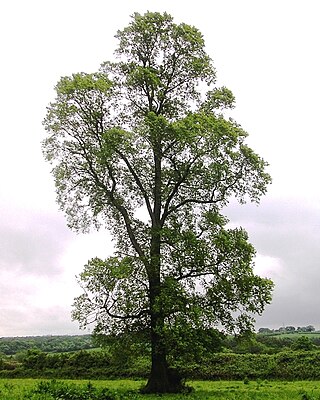
Ulmus minor subsp. minor, the narrow-leaved elm, was the name used by R. H. Richens (1983) for English field elms that were not English elm, Cornish elm, Lock elm or Guernsey elm. Many publications, however, continue to use plain Ulmus minor for Richens's subspecies, a name Richens reserved for the undifferentiated continental field elms. The name Ulmus minor subsp. minor is justified by the existence of at least one other distinctive U. minor subspecies, U. minor subsp. canescens. Dr Max Coleman of Royal Botanic Garden Edinburgh argued in his 2002 paper 'British Elms' that there was no clear distinction between species and subspecies.

Ulmus laevisPall., variously known as the European white elm, fluttering elm, spreading elm, stately elm and, in the United States, the Russian elm, is a large deciduous tree native to Europe, from France northeast to southern Finland, east beyond the Urals into Kyrgyzstan and Kazakhstan, and southeast to Bulgaria and the Crimea; there are also disjunct populations in the Caucasus and Spain, the latter now considered a relict population rather than an introduction by man, and possibly the origin of the European population. U. laevis is rare in the UK, although its random distribution, together with the absence of any record of its introduction, has led at least one British authority to consider it native. NB: The epithet 'white' elm commonly used by British foresters alluded to the timber of the wych elm.

Sir Roland Algernon Penrose was an English artist, historian and poet. He was a major promoter and collector of modern art and an associate of the surrealists in the United Kingdom. During the Second World War he put his artistic skills to practical use as a teacher of camouflage.
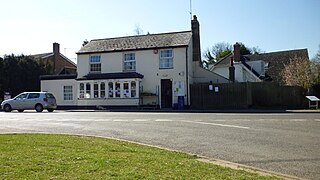
Thriplow is a village in the civil parish of Thriplow and Heathfield, in Cambridgeshire, England, 8 miles (13 km) south of Cambridge. The village also gives its name to a former Cambridgeshire hundred.
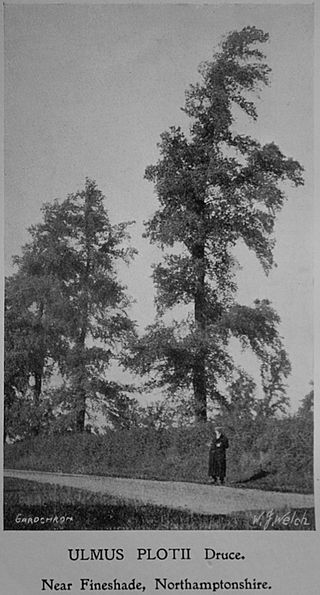
The field elm cultivar Ulmus minor 'Plotii', commonly known as Lock elm or Lock's elm, Plot's elm or Plot elm, and first classified as Ulmus sativaMill. var. Lockii and later as Ulmus plotii by Druce in 1907-11, is endemic mainly to the East Midlands of England, notably around the River Witham in Lincolnshire, in the Trent Valley around Newark-on-Trent, and around the village of Laxton, Northamptonshire. Ronald Melville suggested that the tree's distribution may be related to river valley systems, in particular those of the Trent, Witham, Welland, and Nene. Two further populations existed in Gloucestershire. It has been described as Britain's rarest native elm, and recorded by The Wildlife Trust as a nationally scarce species.
Ellen Hutchins (1785–1815) was an early Irish botanist. She specialised in seaweeds, lichens, mosses and liverworts. She is known for finding many plants new to science, identifying hundreds of species, and for her botanical illustrations in contemporary publications. Many plants were named after her by botanists of the day.
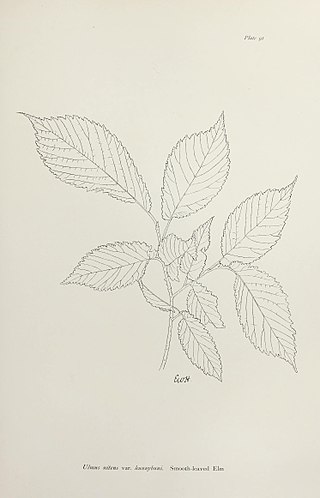
The Field Elm cultivar Ulmus minor 'Hunnybunii' was originally identified as U. nitens var. HunnybuniiMoss by Moss in The Cambridge British Flora (1914). 'Hunnybunii' was reputed to have been commonly planted in the parklands and hedgerows of Essex, Cambridgeshire, and Huntingdonshire before the advent of Dutch elm disease. Melville considered the tree a hybrid of 'Coritana'.

The Field Elm cultivar Ulmus minor 'Sowerbyi', commonly known as the Sowerby Elm, was described by Moss in The Cambridge British Flora (1914). The tree, once referred to as the 'Norfolk Elm' by Smith, was commonly found in the hedgerows and woods of Norfolk, Cambridgeshire, and Huntingdonshire in the early 20th century before the advent of Dutch elm disease. Melville considered it a hybrid of 'Coritana'.

Selinum carvifolia is a flowering plant of the genus Selinum in the family Apiaceae. The specific name carvifolia signifies 'having leaves resembling those of Caraway'. It is a plant of fens and damp meadows, growing in most of Europe, with the exception of much of the Mediterranean region, eastwards to Central Asia. Its common name in English is Cambridge milk parsley, because it is confined, in the UK, to the county of Cambridgeshire and closely resembles milk parsley, an umbellifer of another genus, but found in similar habitats. The two plants are not only similar in appearance, but also grow in similar moist habitats, although they may be told apart in the following manner: P. palustre has hollow, often purplish stems, pinnatifid leaf lobes and deflexed bracteoles; while S. carvifolia has solid, greenish stems, entire or sometimes lobed leaf-lobes and erecto-patent bracteoles. Also, when the two plants are in fruit, another difference becomes apparent: the three dorsal ridges on the fruit of S. carvifolia are winged, while those on the fruit of P. palustre are not. Yet a further difference lies in the respective leaflets of the plants : those of Peucedanum palustre are blunt and pale at the tip, while those of Selinum carvifolia are sharply pointed and of a darker green. S. carvifolia used also to occur in the English counties of Nottinghamshire and Lincolnshire but is now extinct in both. Growing in only three small Cambridgeshire fens, it is one of England's rarest umbellifers. It is naturalized in the United States, where it is known by the common name little-leaf angelica.

Schoenoplectus pungens is a species of flowering plant in the sedge family known as common threesquare, common three-square bulrush and sharp club-rush. It is a herbaceous emergent plant that is widespread across much of North and South America as well as Europe, New Zealand and Australia.

Oenanthe pimpinelloides is a species of flowering plant in the family Apiaceae known by the common name corky-fruited water-dropwort. It is a plant of tall, lightly grazed or infrequently mown grassland and coastal meadows in Europe and neighbouring parts of Asia and North Africa.
William Skrimshire (the younger), (1766 in Wisbech – 22 July 1829) was a surgeon and botanist. He amassed a large herbarium with the help of his brother, Fenwick Skrimshire, although much of it has subsequently been lost. As a surgeon he worked alongside his father at a practice in Ship Lane. After his father's death Skrimshire moved to the edge of the town and there he grew native and exotic plants in his garden and a peppermint plantation. A manuscript catalogue of his collection is all that remains, although it does contain some important first records for Cambridgeshire and Northamptonshire. In 1818 Skrimshire sold the herbarium to Viscount Milton, but continued to gather specimens
Michael Charles Faraday Proctor PhD was an English botanist and plant ecologist, lecturer, scientific author based at the University of Exeter. He retired from his post as Reader in Plant Ecology at Exeter University in 1994.

Allium paradoxum, the few-flowered garlic or few-flowered leek, is an Asian species of wild onion in the Amaryllis family. It is native to mountainous regions of Iran, Caucasus, and Turkmenistan and invasive in Europe.
Mary J. P. "Maura" Scannell (1924–2011) was a leading Irish botanist.
Franklyn Hugh Perring PhD, OBE was a British naturalist, regarded as "one of the most influential botanists and nature conservationists of the 20th century".
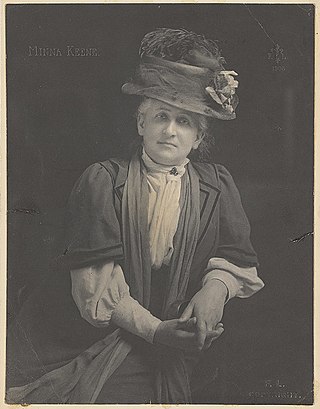
Minna Keene, née Töneböne, was a German-born, self-taught Canadian pictorial portrait photographer, considered "hugely successful".
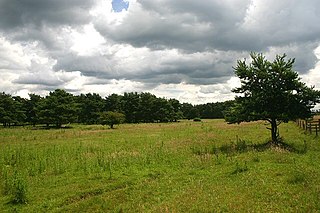
Lakenheath Warren is a 588.3-hectare (1,454-acre) biological Site of Special Scientific Interest south-east of Lakenheath in Suffolk, England. It is a Nature Conservation Review site, Grade I, and part of Breckland Special Area of Conservation and Breckland Special Protection Area under the European Union Directive on the Conservation of Wild Birds. The RAF Lakenheath base is located nearby.
Archibald Sim Montgomrey was a wholesale timber merchant, county councillor and magistrate and amateur plant collector in Britain and other parts of the world.
Christina Mayne Dony was an English botanist and athlete.












